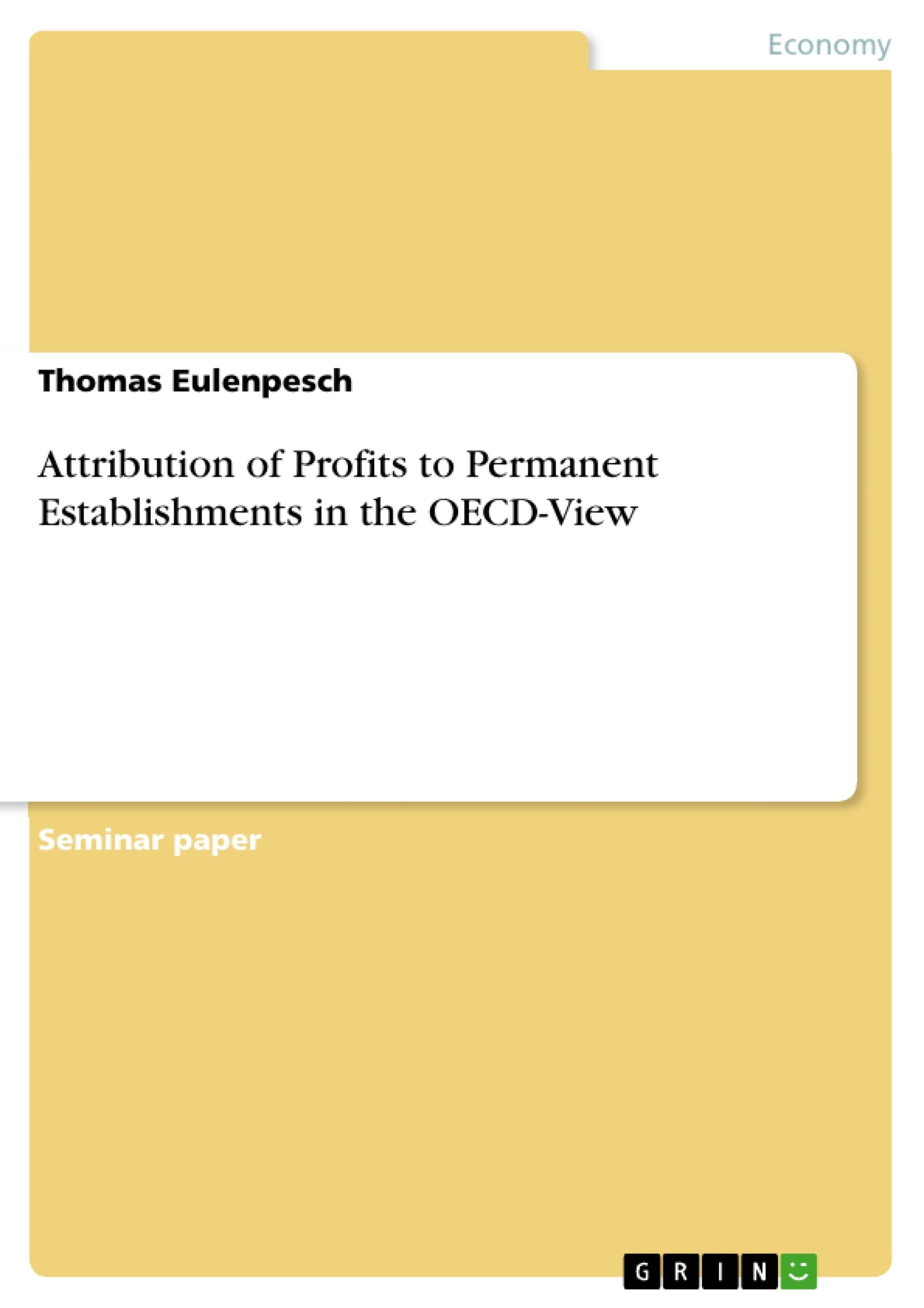In my scientific writing I will write about the attribution of profits to Permanent Establishments in accordance with the updated OECD Model Tax Convention and the OECD Report on the attribution of profits to Permanent Establishments in the Versions of 2008 and 2010.
First I will start with the definition of the Permanent Establishment in the German law and according to the OECD Model Tax Convention.
Afterwards I will continue with the allocation of Profits to the Permanent Establishment by the two step analysis and the different transfer price methods. Additionally I will write about the hypothetical independent enterprises and special regulations for Banks, the trading of financial instruments and Insurance companies.
Inhaltsverzeichnis (Table of Contents)
- INTRODUCTION
- DEFINITION OF THE PERMANENT ESTABLISHMENT
- DEFINITION ACCORDING TO SECTION 12 OF THE GERMAN FISCAL CODE
- DEFINITION ACCORDING TO ARTICLE 5 OECD MODEL TAX CONVENTION
- PERMANENT ESTABLISHMENT IN THE DOUBLE TAXATION AGREEMENT BETWEEN GERMANY AND GREAT BRITAIN
- THE AUTHORISED OECD APPROACH
- THE TWO STEP ANALYSIS FOR THE PERMANENT ESTABLISHMENT A HYPOTHETICAL INDEPENDENT ENTERPRISE
- Analysis of the functions
- Attribution of Assets, Risks and Capital under the OECD Approach
- Attribution of Assets
- Attribution of Risks
- Attribution of Capital
- Determination of the profit of the hypothetical independent Permanent Establishment (Selbstständigkeitsfiktion) as the second step
- Summary of the two Step Analysis
- THE TAX BALANCE SHEET FOR THE PERMANENT ESTABLISHMENT
- Tangible Assets
- Intangible Assets
- TRANSFER PRICES BETWEEN THE MOTHER COMPANY AND THE PERMANENT ESTABLISHMENT
- Transfer Price Methods
- Comparable Uncontrolled Price Method
- Resale Price Method
- Cost-Plus Method
- Transactional Net Margin Method
- Transactional Profit Split Method
- Comparability analysis
- SPECIAL REGULATIONS FOR PE'S OF BANKS
- SPECIAL REGULATIONS FOR THE TRADING OF FINANCIAL INSTRUMENTS
- SPECIAL REGULATIONS FOR PE'S OF INSURANCE COMPANIES
- ATTRIBUTION OF PROFITS TO PERMANENT ESTABLISHMENTS IN THE OECD MODEL TAX CONVENTION
- ARTICLE 7 OF THE OECD MODEL TAX CONVENTION
- PROFIT ALLOCATION ACCORDING TO ARTICLE 7 OF THE OECD MODEL TAX CONVENTION
- THE AUTHORISED OECD APPROACH IN THE GERMAN LAW
- STATUS QOU OF THE PROFIT AND ASSET DETERMINATION
- CHANGE OF THE FOREIGN RELATION TAX ACT
- SUMMARY
Zielsetzung und Themenschwerpunkte (Objectives and Key Themes)
This paper focuses on the attribution of profits to Permanent Establishments (PEs) within the framework of the updated OECD Model Tax Convention and related OECD reports. The primary objective is to examine the allocation of profits to PEs in accordance with both German law and the OECD model, exploring key areas like the definition of a PE, the two-step analysis approach, and various transfer pricing methods.The main themes explored in this paper include:
- Defining and identifying a permanent establishment according to German law and the OECD Model Tax Convention.
- Analyzing the authorized OECD approach for profit attribution to PEs, including the two-step analysis and transfer pricing methods.
- Examining special regulations for PEs in specific industries, such as banking, financial instruments trading, and insurance.
- Analyzing the implementation of the OECD approach within the context of German tax law.
- Highlighting the ongoing developments and changes in the legislation concerning profit attribution to PEs.
Zusammenfassung der Kapitel (Chapter Summaries)
This paper begins by introducing the topic of profit attribution to permanent establishments, setting the context for the subsequent analysis.The second chapter defines the concept of a Permanent Establishment (PE) as it is understood in German law, drawing from the German Fiscal Code and the OECD Model Tax Convention.
Chapter 3 delves into the authorized OECD approach for profit attribution to PEs. It examines the two-step analysis, which involves first assessing the functions performed by the PE and then attributing assets, risks, and capital to it. It also explores various transfer pricing methods used to determine the appropriate profit allocation.
Chapter 4 focuses on the specific regulations related to PEs in the banking, financial instruments trading, and insurance sectors, highlighting the unique considerations for these industries.
Finally, Chapter 5 examines the implementation of the OECD approach within the context of German law, analyzing both the status quo and recent changes in the foreign relation tax act.
Schlüsselwörter (Keywords)
The main focus of this paper lies in the attribution of profits to Permanent Establishments (PEs), exploring the relevant provisions within both the updated OECD Model Tax Convention and German law. This analysis delves into the definition of PEs, the authorized OECD approach for profit allocation, including the two-step analysis and various transfer pricing methods. Furthermore, the paper examines special regulations for PEs in banking, financial instruments trading, and insurance, as well as the implementation of the OECD approach within the context of German tax law. Key concepts explored include the hypothetical independent enterprise, transfer pricing methods (such as comparable uncontrolled price, resale price, cost-plus, transactional net margin, and transactional profit split), and the allocation of assets, risks, and capital to PEs.- Quote paper
- Thomas Eulenpesch (Author), 2012, Attribution of Profits to Permanent Establishments in the OECD-View, Munich, GRIN Verlag, https://www.grin.com/document/200756




